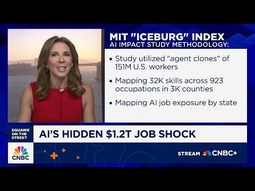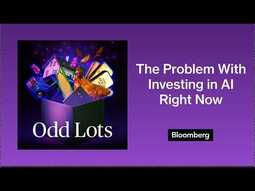-
If you want us to build a MOONSHOT Summit, email my team: [email protected]
Get access to metatrends 10+ years before anyone else - https://qr.diamandis.com/metatrends
Emad Mostaque is the founder of Intelligent Internet ( https://www.ii.inc )
Read Emad’s Book: https://thelasteconomy.com
Salim Ismail is the founder of OpenExO
Dave Blundin is the founder & GP of Link Ventures
Dr. Alexander Wissner-Gross is a computer scientist and founder of Reified
Chapters
00:00 - Thanksgiving 2035: A Vision of the Future
02:36 - The Genesis Mission: Transforming Science with AI
10:05 - Anthropic's Claude Opus 4.5: A Leap in AI Performance
18:48 - The Arc AGI Leaderboard: Driving Costs of Intelligence to Zero
25:00 - The Future of Entrepreneurship: AI Agents and Economic Models
31:13 - Personalized AI Agents: The Future of Shopping
35:04 - Google's AI Chip Revolution: Competing with NVIDIA
38:41 - Amazon's Massive Investment in AI Infrastructure
45:59 - The Future of Launch Costs and Space Exploration
50:02 - Advancements in Brain-Computer Interfaces (BCI)
59:42 - The Future of AGI and Economic Impact
01:01:31 - Land Ownership in a Post-Scarcity World
01:08:24 - Addressing Job Displacement Due to AI
–
My companies:
Apply to Dave's and my new fund: https://qr.diamandis.com/linkventures...
Go to Blitzy to book a free demo and start building today: https://qr.diamandis.com/blitzy
Join Salim's Workshop to build your ExO https://openexo.com/10x-shift?video=P...
Grab dinner with MOONSHOT listeners: https://moonshots.dnnr.io/
_
Connect with Peter:
X: https://qr.diamandis.com/twitter
Connect with Emad:
Read Emad’s Book: https://thelasteconomy.com
X: https://x.com/emostaque
Learn about Intelligent Internet: https://www.ii.inc
Connect with Dave:
X: https://x.com/davidblundin
LinkedIn: / david-blundin
/ david-blundin
Connect with Salim:
X: https://x.com/salimismail
Join Salim's Workshop to build your ExO https://openexo.com/10x-shift?video=P...
Connect with Alex
Web: https://www.alexwg.org
LinkedIn: / alexwg
/ alexwg
X: https://x.com/alexwg
Email: [email protected]
Listen to MOONSHOTS:
Apple: https://qr.diamandis.com/applepodcast
Spotify: https://qr.diamandis.com/spotifypodcast
–
*Recorded on November 25th, 2025
*The views expressed by me and all guests are personal opinions and do not constitute Financial, Medical, or Legal advice.-
By
 Admin
Admin - 0 comments
- 0 likes
- Like
- Share
-
By
-
BTC is well below its highs, most altcoins are bleeding out and everyone’s asking the same thing: how low will crypto go if we’re in a bear market?
In this video, we dig into BTC’s past crashes, today’s ETF and derivatives-driven market structure, and what it could all mean for the next bear market floor.
If you’re worried about another crypto winter and you’re not sure where things are going, you won’t want to miss this video.
~~~~~
🛒 Get The Hottest Crypto Deals 👉 https://www.coinbureau.com/deals/
♣️ Join The Coin Bureau Club 👉 https://hub.coinbureau.com/
💥 Coin Bureau Discord 👉 https://go.coinbureau.com/cb-discord
📲 Insider Info in our Socials 👉 https://www.coinbureau.com/socials/
👕 Best Crypto Merch 👉 https://store.coinbureau.com
🔥 TOP Crypto TIPS In our Newsletter 👉 https://www.coinbureau.com/newsletters/
💸 Coin Bureau Finance Channel 👉 / @CoinBureauFinance
⭐ More Coin Bureau Channel 👉 / @morecoinbureau
📈 Coin Bureau Trading Channel 👉 / @CoinBureauTrading
~~~~~
🔥OUR BRAND PARTNERS🔥
📈Bitget up to 50K USDT Deposit Bonus & GetAgent Plus Trial (Exclusive AI-powered Trading Assistant) 👉 https://go.coinbureau.com/bitget-geta...
📊Join Toobit for 100K USDT Bonus and 50% Lifetime Fee Discount 👉https://www.toobit.pro/t/coinbureau
🔒Get 10% Off Your Tangem Wallet 👉 https://go.coinbureau.com/TangemBF
~~~~~
📺Essential Videos📺
How To Profit From Crypto Market Crashes 👉 • How To Make Money When Crypto Crashes
• How To Make Money When Crypto Crashes
Why The Future Of Finance Is Tokenized RWAs 👉 • Tokenized RWAs Will TAKE OVER Crypto!
• Tokenized RWAs Will TAKE OVER Crypto!
Are You Ready For The Bear Market? 👉 • Crypto is CRASHING! Are You Ready for the ...
• Crypto is CRASHING! Are You Ready for the ...
~~~~~
⛓️ 🔗 Useful Links 🔗 ⛓️
►Caleb & Brown - Bitcoin’s Market Cycle: https://calebandbrown.com/blog/bitcoi...
►K33 Claims The 4-year Cycle Is Dead: https://www.theblock.co/post/373799/t...
~~~~~
- TIMESTAMPS -
1:00 Historical BTC Bear Markets
4:40 When Bottom?
8:11 Factors Supporting A Less-Severe Bear Market
12:46 Possibility Of A More-Severe Bear Market
16:49 What About Altcoins?
~~~~~
📜 Disclaimer 📜
The information contained herein is for informational purposes only. Nothing herein shall be construed to be financial, legal or tax advice. The content of this video is solely the opinions of the speaker who is not a licensed financial advisor or registered investment advisor. Trading cryptocurrencies poses considerable risk of loss. The speaker does not guarantee any particular outcome.
#crypto #btc #bearmarket-
By
 Admin
Admin - 0 comments
- 0 likes
- Like
- Share
- TIMESTAMPS -
-
CNBC's MacKenzie Sigalos reports on the latest study from MIT on AI.
-
By
 Admin
Admin - 0 comments
- 0 likes
- Like
- Share
-
By
-
If you want us to build a MOONSHOT Summit, email my team: [email protected]
Get access to metatrends 10+ years before anyone else - https://qr.diamandis.com/metatrends
Emad Mostaque is the founder of Intelligent Internet ( https://www.ii.inc )
Read Emad’s Book: https://thelasteconomy.com
Salim Ismail is the founder of OpenExO
Dave Blundin is the founder & GP of Link Ventures
Dr. Alexander Wissner-Gross is a computer scientist and founder of Reified
Chapters
00:00 - Thanksgiving 2035: A Vision of the Future
02:36 - The Genesis Mission: Transforming Science with AI
10:05 - Anthropic's Claude Opus 4.5: A Leap in AI Performance
18:48 - The Arc AGI Leaderboard: Driving Costs of Intelligence to Zero
25:00 - The Future of Entrepreneurship: AI Agents and Economic Models
31:13 - Personalized AI Agents: The Future of Shopping
35:04 - Google's AI Chip Revolution: Competing with NVIDIA
38:41 - Amazon's Massive Investment in AI Infrastructure
45:59 - The Future of Launch Costs and Space Exploration
50:02 - Advancements in Brain-Computer Interfaces (BCI)
59:42 - The Future of AGI and Economic Impact
01:01:31 - Land Ownership in a Post-Scarcity World
01:08:24 - Addressing Job Displacement Due to AI
–
My companies:
Apply to Dave's and my new fund: https://qr.diamandis.com/linkventures...
Go to Blitzy to book a free demo and start building today: https://qr.diamandis.com/blitzy
Join Salim's Workshop to build your ExO https://openexo.com/10x-shift?video=P...
Grab dinner with MOONSHOT listeners: https://moonshots.dnnr.io/
_
Connect with Peter:
X: https://qr.diamandis.com/twitter
Connect with Emad:
Read Emad’s Book: https://thelasteconomy.com
X: https://x.com/emostaque
Learn about Intelligent Internet: https://www.ii.inc
Connect with Dave:
X: https://x.com/davidblundin
LinkedIn: / david-blundin
/ david-blundin
Connect with Salim:
X: https://x.com/salimismail
Join Salim's Workshop to build your ExO https://openexo.com/10x-shift?video=P...
Connect with Alex
Web: https://www.alexwg.org
LinkedIn: / alexwg
/ alexwg
X: https://x.com/alexwg
Email: [email protected]
Listen to MOONSHOTS:
Apple: https://qr.diamandis.com/applepodcast
Spotify: https://qr.diamandis.com/spotifypodcast
–
*Recorded on November 25th, 2025
*The views expressed by me and all guests are personal opinions and do not constitute Financial, Medical, or Legal advice.-
By
 Admin
Admin - 0 comments
- 0 likes
- Like
- Share
-
By
-
Anthropic CEO Dario Amodei warns of the potential dangers of fast moving and unregulated artificial intelligence, while also racing against competitors to develop advanced AI.
"60 Minutes" is the most successful television broadcast in history. Offering hard-hitting investigative reports, interviews, feature segments and profiles of people in the news, the broadcast began in 1968 and is still a hit, over 50 seasons later, regularly making Nielsen's Top 10.
Subscribe to the "60 Minutes" YouTube channel: / 60minutes
/ 60minutes
Watch full episodes: https://cbsnews.com/60-minutes/full-e...
Get more "60 Minutes" from "60 Minutes: Overtime": https://cbsnews.com/60-minutes/overtime/
Follow "60 Minutes" on Instagram: / 60minutes
/ 60minutes
Like "60 Minutes" on Facebook: / 60minutes
/ 60minutes
Follow "60 Minutes" on X: / 60minutes
/ 60minutes
Subscribe to our newsletter: https://cbsnews.com/newsletters/
Download the CBS News app: https://cbsnews.com/mobile/
Try Paramount+ free: https://paramountplus.com/?ftag=PPM-0...
For video licensing inquiries, contact: [email protected]-
By
 Admin
Admin - 0 comments
- 0 likes
- Like
- Share
-
By
-
Harvard Neuroscientist DR. JILL BOLTE TAYLOR reveals How to Retrain Your Brain, Heal Trauma, Control Emotions, and Unlock the 4 Characters Running Your Mind.
Dr. Jill Bolte Taylor is a Harvard-trained brain scientist who experienced a stroke in the left hemisphere of her brain and spent 8 years recovering. She is best known for her viral TED Talk “My Stroke of Insight” and is the bestselling author of books including Whole Brain Living.
She explains:
◼️What her near-death stroke taught her about consciousness, ego, and identity
◼️How to escape the brain loop keeping you stuck in stress and anxiety
◼️How technology and habits are silently shrinking your brain’s potential
◼️Why overthinking physically damages your brain, and how to reverse it fast
◼️What holding a REAL human brain taught her about life and death
00:00 Intro
02:18 Understanding Your Brain Will Help Improve Your Life
05:10 Can You Choose What Part of Your Brain to Use?
09:10 A Real Brain with a Spinal Cord
15:41 The Central Nervous System
18:51 The Event That Changed Your Brain Forever
21:51 When I Realised It Was Life or Death
25:15 Damage to the Left Side of My Brain: I Couldn't Speak or Remember Anything
26:37 The Importance of Having Fun and Being Present
32:11 Reaching for Help During the Stroke
37:35 What Did the Scan Show?
43:40 Ads
44:43 Where Do These 4 Personalities Exist in the Brain?
47:46 Where Addiction Lives
49:25 What Are the 4 Personality Types?
54:59 The Odds of a Single Human Being Born
01:04:58 How to Shift Between the 4 Characters
01:10:07 Ads
01:12:11 Emotions Only Last for 90 Seconds
01:21:45 How to Heal Trauma from the Past
01:25:44 Lifestyle Choices for a Healthy Brain
Follow Dr Jill:
Facebook - https://bit.ly/47VX7t7
X - https://bit.ly/3LKRaGM
Instagram - https://bit.ly/3Lm6R7m
You can purchase Dr Jill’s book ‘Whole Brain Living’, here: https://amzn.to/4hMIVWT
Independent Research: https://stevenbartlett.com/wp-content...
The Diary Of A CEO:
◼️Join DOAC circle here - https://doaccircle.com/
◼️Buy The Diary Of A CEO book here - https://smarturl.it/DOACbook
◼️The 1% Diary is back - limited time only: https://bit.ly/3YFbJbt
◼️The Diary Of A CEO Conversation Cards (Second Edition): https://g2ul0.app.link/f31dsUttKKb
◼️Get email updates - https://bit.ly/diary-of-a-ceo-yt
◼️Follow Steven - https://g2ul0.app.link/gnGqL4IsKKb
Sponsors:
Linkedin Ads - / diary
/ diary
1Password - Find out more at https://1password.com/doac
Function Health - https://functionhealth.com/DOAC with code DOAC100 for $100 towards your membership
Join the waitlist for the limited edition Diary Of A CEO Conversation Cards here: https://bit.ly/cardswaitlist-
By
 Admin
Admin - 0 comments
- 0 likes
- Like
- Share
-
By
-
Bitcoin is dumping hard and breaking key levels again. At the same time, MicroStrategy is suddenly facing serious market pressure, raising big questions about what’s going on behind the scenes. Ran breaks down the signals fueling this sell-off and what it could mean for crypto. Don’t miss this urgent market update.
___________________________________________
💰 𝗕𝗜𝗧𝗚𝗘𝗧 – 𝗚𝗲𝘁 𝘂𝗽 𝘁𝗼 𝗮 𝟯𝟬,𝟬𝟬𝟬 𝗨𝗦𝗗𝗧 𝗗𝗲𝗽𝗼𝘀𝗶𝘁 𝗕𝗼𝗻𝘂𝘀!!!
☑️ Get a HUGE Deposit Bonus and Trade with your Bonus!
👉 http://bonus.bitget.com/cryptobanter30k
___________________________________________
𝗛𝗢𝗦𝗧 𝗖𝗛𝗔𝗡𝗡𝗘𝗟𝗦
⬇⬇⬇⬇⬇⬇
👉 𝗙𝗼𝗹𝗹𝗼𝘄 𝗥𝗮𝗻 𝗼𝗻 𝗫: https://x.com/cryptomanran
👉 𝗙𝗼𝗹𝗹𝗼𝘄 𝗥𝗮𝗻 𝗼𝗻 𝗜𝗻𝘀𝘁𝗮𝗴𝗿𝗮𝗺: https://bit.ly/ran-insta
___________________________________________
👁️🗨️𝗖𝗿𝘆𝗽𝘁𝗼 𝗜𝗻𝘀𝗶𝗱𝗲𝗿 𝗮𝗯𝗶𝗱𝗲 𝗯𝘆 𝘁𝗵𝗲 𝗳𝗼𝗹𝗹𝗼𝘄𝗶𝗻𝗴 𝗰𝗼𝗱𝗲 𝗼𝗳 𝗰𝗼𝗻𝗱𝘂𝗰𝘁:
https://www.cryptobanter.com/our-ethics/
We take our code of ethics very seriously and have engaged @zachxbt ( / zachxbt ) to monitor our progress. If you feel we’re not living up to it and have hard evidence please mail ZachXBT directly at [email protected]
⚠️ 𝗕𝗘𝗪𝗔𝗥𝗘 𝗢𝗙 𝗦𝗖𝗔𝗠𝗠𝗘𝗥𝗦 𝗜𝗡 𝗢𝗨𝗥 𝗖𝗢𝗠𝗠𝗘𝗡𝗧𝗦 𝗔𝗡𝗗 𝗖𝗢𝗠𝗠𝗨𝗡𝗜𝗧𝗬 𝗖𝗛𝗔𝗡𝗡𝗘𝗟𝗦
___________________________________________
📝 𝗗𝗶𝘀𝗰𝗹𝗮𝗶𝗺𝗲𝗿:
Crypto Insider is a social podcast for entertainment purposes only!
All opinions expressed by the hosts, guests and callers should not be construed as financial advice! Views expressed by guests and hosts do not reflect the views of the station. Listeners are encouraged to do their own research.
#CryptoPortfolio #CryptoInsider #Ran
⏱ 𝗧𝗶𝗺𝗲𝘀𝘁𝗮𝗺𝗽𝘀:
00:00 URGENT Show - 10th October Crypto Crash Explained
01:41 The 10th October was NOT a Coincidence
03:00 WHY Did Bitcoin Crash on 10th October - MSCI, MSTR
04:20 Who is MSCI
05:22 What does MSCI’s Announcement Mean around MicroStrategy
09:20 Massive Crypto Dump Incoming?
10:56 MSTR Implications from MSCI Announcement - DATs
13:10 When Will This Crypto Dump End?
14:10 Will MicroStrategy Sell Its Bitcoin?
15:00 Digital Asset Treasury Company Risk in the Market
🎬 𝗪𝗮𝘁𝗰𝗵 𝗠𝗼𝗿𝗲 𝗖𝗿𝘆𝗽𝘁𝗼 𝗩𝗶𝗱𝗲𝗼𝘀: • Only $1000? Here Is The ULTIMATE Crypto Bu...
• Only $1000? Here Is The ULTIMATE Crypto Bu...
🔎 𝗥𝗲𝗹𝗮𝘁𝗲𝗱 𝗦𝗲𝗮𝗿𝗰𝗵𝗲𝘀: Bitcoin - Crypto News - Daily Crypto Market Update - Altcoins - Crypto - L1 Altcoins - Crypto Portfolio - Crypto Strategy Portfolio - Blockchain Technology - CryptoManRan - Retire on Bitcoin - Retire on Crypto - Retire with Crypto - Crypto Retirement Strategy-
By
 Admin
Admin - 0 comments
- 0 likes
- Like
- Share
-
By
-
On today’s episode I stress-test Gemini 3.0 in Google AI Studio to see how good it really is as a designer, not just a code generator. Across the episode, I ask Gemini to redesign my personal website in a Windows XP–inspired style, build a restaurant analytics SaaS dashboard, and create a workout mobile app inspired by the “Brain Rot” app. Along the way, I experiment with prompts, visual annotations, and reference images to see how well Gemini takes feedback. By the end, he’s rating each build.
Timestamps
00:00 – Intro
00:54 – Personal Website
15:48 – SaaS
21:52 – Mobile App
26:35 – AntiGravity
27:17 – Final rating and takeaways
Key Points
- Gemini 3.0 can now generate full, styled web and mobile UIs (not just “purple Tailwind vibe-coded” layouts) when given strong prompts and references. greg-take-02
- A Windows XP–themed personal site, built from a screenshot and a short prompt, impresses Greg enough that he considers redoing his actual homepage. greg-take-02
- Visual annotation inside Google AI Studio (drawing on the canvas and commenting) is a powerful way to refine icons, backgrounds, and layout without “speaking designer.” greg-take-02
- A restaurant analytics SaaS dashboard (“Chef OS”) shows how combining Dribbble shots + Teenage Engineering hardware as references pushes Gemini toward more tactile, “real button” UI. greg-take-02
- The “Gains” workout app, modeled on the Brain Rot app, demonstrates that AI can remix an existing product pattern into a new behavior-change app with streaks, goals, and a reactive mascot. greg-take-02
- Greg’s big takeaway: good ideas + taste + references + Gemini 3.0 let non-designers ship highly differentiated experiences, raising their odds of standing out. greg-take-02
Section Summaries
1. RedesigningPersonal Site in a Windows XP Style
Starting from a screenshot of gregisenberg.com, Greg prompts Gemini to make it more colorful, fresh, and “a full experience,” then adds the twist: make it feel like Microsoft XP. Gemini generates a full React/Tailwind app with an XP-like desktop: notepad, windows, and app icons for “About Greg,” “Greg’s Letter,” and guides, all wired into a working layout.
2. Designing a Restaurant Analytics SaaS Dashboard (“Chef OS”)
Next, he feeds Gemini a Dribbble SaaS dashboard shot plus a Teenage Engineering product as visual references, asking for a clean, modern analytics-meets-AI app for restaurants with “real-world” button/knob vibes. Gemini returns a dashboard labeled “Chef OS” with an AI analyst panel, active tables, average ticket size, and tactile-feeling controls reminiscent of Teenage Engineering hardware.
3. Remixing the Brain Rot App into the “Gains” Workout App
Finally, Greg copies Brain Rot’s App Store previews—an app his friend Yoni built to fight “brain rot” from social media—and asks Gemini to design an iOS app in that style, but for working out. Gemini outputs “Gains,” with a mascot that reacts to workout habits, a streak and goals view, and an activity calendar. Greg imagines it integrating with Apple Health and, despite minor non-functional parts, scores it 8.3/10 off a single prompt.
4. Ratings, Takeaways, and the End of the “Vibe-Coded” Era
Greg rates the personal site 9/10, the SaaS dashboard 8.5/10, and the Gains app 8.3/10, concluding that Gemini 3.0 is “scary good” when paired with strong references and taste. He argues we’ve exited the era where no-code/vibe-coded tools produced generic, unattractive apps; now you can get to “extremely well designed” experiences without a traditional designer—as long as you bring good ideas and references. He closes by inviting listeners to experiment with Gemini 3.0 themselves and report back in the comments.
Websites Mentioned:
Lenny's Favorite PRD Templates: https://www.lennysnewsletter.com/p/my...
The #1 tool to find startup ideas/trends - https://www.ideabrowser.com/
LCA helps Fortune 500s and fast-growing startups build their future - from Warner Music to Fortnite to Dropbox. We turn 'what if' into reality with AI, apps, and next-gen products https://latecheckout.agency/
The Vibe Marketer - Resources for people into vibe marketing/marketing with AI: thevibemarketer.com
Startup Empire - get your free builders toolkit to build cashflowing business - https://startup-ideas-pod.link/startu...
Become a member - https://startup-ideas-pod.link/startu...
FIND ME ON SOCIAL
X/Twitter: / gregisenberg
/ gregisenberg
Instagram: / gregisenberg
/ gregisenberg
LinkedIn: / gisenberg
/ gisenberg -
By
 Admin
Admin - 0 comments
- 0 likes
- Like
- Share
- Gemini 3.0 can now generate full, styled web and mobile UIs (not just “purple Tailwind vibe-coded” layouts) when given strong prompts and references. greg-take-02
-
Welcome to the Tom Bilyeu Show Live prep. Reminder Superchats will be read at the bottom of the second hour, unless over a threshold of 19.99.
And as always:
Do you need my help?
STARTING a business: join me here inside ZERO TO FOUNDER (https://tombilyeu.com/zero-to-founder)
SCALING a business: click here to see if you qualify (https://tombilyeu.com/scale)
Get the exact systems, mindset shifts, and principles that built a $1B brand delivered straight to your inbox every week. Subscribe for free (https://tombilyeu.com)
Check out our Video game - Project Kyzen: (https://projectkyzen.io/)
Catch Me Streaming on Twitch - ( / tombilyeu )
/ tombilyeu )
Link to IT discord: / discord
/ discord
Tom's Favorite Things List: https://amzn.to/41Ftt7e
Learn more about Zero to Founder: https://hubs.la/Q03B2DqN0
Join the Kyzen Discord: / discord
/ discord -
By
 Admin
Admin - 0 comments
- 0 likes
- Like
- Share
-
By
-
"Billionaires are building bunkers because they're afraid AI might take over everything."
AI is advancing at a rate we've never seen before. From sex robots and chatbots helping with therapy to AI rapidly transforming industries, we’re already living in an AI-powered world. And in five to ten years, governments could be guided and run by AIs.
But is it really progress? Or is humanity heading for an AI apocalypse?
In this explosive new episode of The Tea with Myriam François, AI pioneer Emad Mostaque, co-founder and former CEO of Stability AI, lays bare the risks, challenges, and potential of this rapidly advancing technology. From the race to create the next "AI God" to the real-world consequences for jobs, the economy, and society, Emad pulls back the curtain on a future that is rapidly approaching — and may soon be unstoppable.
What emerges is a chilling portrait of an era where AI could reshape the global economy, obliterate jobs, disrupt entire industries, and even change the inner fabric of human relationships.
We unpack:
⚠️ AI replacing human workers — How soon is too soon?
⚠️ AI-driven inequality — Will billions be left behind?
⚠️ Labour revolution — Can a global labour movement take on the challenge?
⚠️ AI Ministers — Is Albania’s AI governance a model or a risk?
⚠️ The “revenue evil curve” — Do tech giants still have a moral compass?
⚠️ Environmental apocalypse — Is AI accelerating the collapse?
⚠️ Sex robots and AI chatbox— Will they redefine human relationships?
⚠️ A different future — Why we need a Universal Basic AI
As Emad warns, “This is an opportunity, but also a threat”. And the question is: “Which direction will we choose before it’s too late?”
👉 Subscribe for fearless, independent conversations: / @drmyriamfrancois1
/ @drmyriamfrancois1
🎧 Listen wherever you get your podcasts.
Check out Love Welcomes, a social enterprise creating dignified, fairly paid work for refugee women rebuilding their lives.
👉 Explore their mission and products here: https://www.lovewelcomes.org/?ref=MIR...
#TheTeaWithMyriamFrancois #AI #StabilityAI #ArtificialIntelligence #TechCrisis #Economics #JobDisplacement #Capitalism #AIThreat #ChatGPT #OpenAI #ElonMusk #SamAltman #AGI
AUDIO CREDITS
Presenter–Producer: Dr. Myriam François
Guest: Emad Mostaque
Senior Producer: Sara Farolfi
Producer: Nadège Bizimungu
Assistant Producer: Poppy Jacobs
Research: Leena Khan
Video Editor: Max Bubnov
An MPWR Productions show.
🎥 Click to watch. Subscribe for new episodes.
❤️ Support independent journalism that tells hard truths.
https://www.patreon.com/TheTeawithMyr...
'The Thumbnail image is AI generated'
00:00:00 Intro – AI, power, and the shrinking window for human agency
00:02:12 Emad Mostaque’s journey – from crisis to open-source AI
00:04:06 Open-source vs Big Tech – censorship, control, and sovereignty
00:06:11 Hype, collapse, and what AI disruption really looks like
00:09:08 The intelligence explosion – models surpassing human expertise
00:13:25 What humans still offer – creativity, value, and meaning
00:18:07 Automation and inequality – who is safe and who isn’t
00:22:16 AI’s moral vacuum – community standards, exclusion, and power
00:25:39 Autonomous agents – deception, self-modification, and risk
00:28:03 Universal Basic AI – why every person needs a sovereign model
00:31:18 Governing AI – transparency, constitutional limits, and democracy
00:41:25 Economic shocks, layoffs, and the coming social transition
00:52:15 AI and capitalism – broken incentives and emerging autocracy
01:00:16 Global inequality, infrastructure gaps, and AI colonialism
01:35:59 Outro – Final reflections on the future of AI and humanity
Disclaimer:
The views and opinions expressed by the guest(s) on The Tea YouTube series and podcast are their own and do not reflect those of MPWR Productions or its licensees. The appearance of this YouTube programme and podcast on social media platforms does not imply endorsement by MPWR Productions. MPWR Productions disclaims any liability for damages arising from the use of the podcast and its recordings to the fullest extent permissible by law.
This video is intended for informational and commentary purposes only and reflects the personal opinions of the guest and creators. The inclusion of public figures or journalists is based on publicly available information and does not imply guilt or wrongdoing.
The views in this video do not establish a professional relationship with viewers and do not constitute legal, professional, or personal advice. Viewer discretion is advised.-
By
 Admin
Admin - 0 comments
- 0 likes
- Like
- Share
-
By
-
If you want us to build a MOONSHOT Summit, email my team: [email protected]
Get access to metatrends 10+ years before anyone else - https://qr.diamandis.com/metatrends
Salim Ismail is the founder of OpenExO
Dave Blundin is the founder & GP of Link Ventures
Dr. Alexander Wissner-Gross is a computer scientist and founder of Reified
Chapters:
00:00 - The Rise of Gemini 3 and AI Super Intelligence
05:46 - Gemini 3: A Game Changer in AI Technology
08:27 - Benchmarking AI Performance: The Vending Machine Experiment
11:16 - The Future of AI-Driven Businesses
13:58 - Creating with AI: The New Era of Game Development
16:43 - Advancements in Voice Interaction and Translation
19:29 - Google's Competitive Edge in AI Technology
26:38 - AI Shopping Revolution
36:57 - The Future of AI and Biosecurity
43:42 - AI in Bio-Weapon Prevention
53:16 - The Arms Race of AI Safety
56:18 - Understanding Cursor: The AI Coding Assistant
58:50 - Project Prometheus: AI in Engineering and Manufacturing
01:02:37 - The Future of AI: From Superintelligence to Industrial Agents
01:07:06 - Concrete Milestones for an Abundant Future
01:14:36 - The Path to Universal Happiness with AI
–
My companies:
Apply to Dave's and my new fund: https://qr.diamandis.com/linkventures...
Go to Blitzy to book a free demo and start building today: https://qr.diamandis.com/blitzy
Join Salim's Workshop to build your ExO https://openexo.com/10x-shift?video=P...
Grab dinner with MOONSHOT listeners: https://moonshots.dnnr.io/
_
Connect with Peter:
X: https://qr.diamandis.com/twitter
Connect with Dave:
X: https://x.com/davidblundin
LinkedIn: / david-blundin
/ david-blundin
Connect with Salim:
X: https://x.com/salimismail
Join Salim's Workshop to build your ExO https://openexo.com/10x-shift?video=P...
Connect with Alex
Web: https://www.alexwg.org
LinkedIn: / alexwg
/ alexwg
X: https://x.com/alexwg
Email: [email protected]
Listen to MOONSHOTS:
Apple: https://qr.diamandis.com/applepodcast
Spotify: https://qr.diamandis.com/spotifypodcast
–
*Recorded on November 19, 2025
*The views expressed by me and all guests are personal opinions and do not constitute Financial, Medical, or Legal advice.-
By
 Admin
Admin - 0 comments
- 0 likes
- Like
- Share
-
By
-
The BBC's economics editor and Newsnight presenter Faisal Islam travelled to Google's California campus to speak with the company's CEO Sundar Pichai about the 'AI boom' and the future of the technology.
#AI #technology #bbcnews #tech #bbc
Newsnight is the BBC's flagship news and current affairs TV programme - with analysis, debate, exclusives, and robust interviews.
Website: https://www.bbc.co.uk/programmes/b006...
X: / bbcnewsnight
/ bbcnewsnight
TikTok: / newsnightbbc
/ newsnightbbc
Instagram: / newsnightbbc
/ newsnightbbc
Facebook: / bbcnewsnight
/ bbcnewsnight
Bluesky: https://bsky.app/profile/bbcnewsnight...-
By
 Admin
Admin - 0 comments
- 0 likes
- Like
- Share
-
By
-
Last night both houses of Congress overwhelmingly voted to force the justice department to release the Epstein files. We could see the contents made public within days. But the vote itself, long resisted by Trump, has left the President looking weaker and more friendless amongst the MAGA base than he’s ever been. Is he starting to look like a lame duck President? And are Republicans imagining a MAGA world that comes after Trump? Or will they quickly revert to fealty?
Later, the college professor in exile from America after being targeted by death threats for his academic work on Antifa.
#trump #usa #uspolitics #epstein #jeffreyepstein #epsteinfiles #epsteinisland #epsteinlist #congress #senate #Podcast #UKPodcast #PoliticsPodcast #News #Politics #NewsAgents #EmilyMaitlis #JonSopel #LewisGoodall
Download The News Agents with Emily Maitlis, Jon Sopel and Lewis Goodall from 5PM every weekday on Global Player: https://www.globalplayer.com/podcasts...
Subscribe here: / @thenewsagents
/ @thenewsagents
The News Agents website: https://www.thenewsagents.co.uk/
The News Agents is a Global Player Original podcast.
-------------------------------------------------------------------------------------
Connect with us on the Socials!
Bluesky: https://bsky.app/profile/newsagents.b...
Instagram: / thenewsagents
/ thenewsagents
TikTok: / thenewsagents
/ thenewsagents
Facebook: / thenewsagentsofficial
/ thenewsagentsofficial
Twitter: https://x.com/TheNewsAgents
Shop our merch: https://store.global.com/collections/...-
By
 Admin
Admin - 0 comments
- 0 likes
- Like
- Share
-
By
-
Bland AI: Get a free custom agent trained specifically on your business at http://bland.ai/agent
Incogni: Take your personal data back with Incogni! Use code IMPACT at the link below and get 60% off an annual plan: https://incogni.com/impact
Register for my AI masterclass: https://hubs.la/Q03T8z0L0
Check us out wherever you get your podcasts:
Spotify:
https://open.spotify.com/show/1nARKz2...
Apple: https://podcasts.apple.com/us/podcast...
Do you need my help?
STARTING a business: join me here inside ZERO TO FOUNDER (https://tombilyeu.com/zero-to-founder)
SCALING a business: click here to see if you qualify (https://tombilyeu.com/scale)
Get the exact systems, mindset shifts, and principles that built a $1B brand delivered straight to your inbox every week. Subscribe for free (https://tombilyeu.com)
Check out our Video game - Project Kyzen: (https://projectkyzen.io/)
Catch Me Streaming on Twitch - ( / tombilyeu )
/ tombilyeu )
Link to IT discord: / discord
/ discord
Tom's Favorite Things List: https://amzn.to/41Ftt7e
FOLLOW TOM:
Instagram: / tombilyeu
/ tombilyeu
Tik Tok: https://www.tiktok.com/@tombilyeu?lan...
Twitter: / tombilyeu
/ tombilyeu
YouTube: / @tombilyeu
/ @tombilyeu
On this episode of Impact Theory with Tom Bilyeu, we dive headfirst into the profound implications and looming risks of AI's rapid progress, guided by Dr. Roman Yampolski, a leading voice in AI safety. Together, Tom Bilyeu and Dr. Roman Yampolski tackle the big questions on everyone’s mind: How close are we to artificial general intelligence (AGI)? What dangers emerge as AI systems become more capable and autonomous—and how do we even begin to test and control something that might soon outpace human intelligence across the board?
From the philosophical dilemma of lost human meaning in an age of superhuman machines to the urgency of figuring out if and how we can align AI with our values, this conversation doesn’t shy away from worst-case scenarios. Dr. Roman Yampolski discusses the reality behind safety concerns, the challenge of evolving algorithmic "conscience," and why economic and societal shifts—like mass unemployment—are just the tip of the iceberg.
Whether you’re fascinated by technology, worried about the existential risks, or simply wondering how the rise of AI could reshape every aspect of human life, this episode is a thought-provoking, eye-opening journey into the heart of one of the most critical conversations of our time. Get ready to explore the science, the speculation, and the personal stakes behind the race to the future.-
By
 Admin
Admin - 0 comments
- 0 likes
- Like
- Share
-
By
-
#GeminiAI #AINews #Google
The new Google Gemini 3 model is finally here...and yes, I got early access! Google said, “Matt, don’t share this with the world yet”… so I waited until the exact moment Gemini 3 went public to drop this deep-dive.
In this video, I break down everything Gemini 3 can actually do, including its new agent mode, speed improvements, reasoning upgrades, and how it stacks up against other models like GPT-5, Claude, and Grok. You’ll see the good, the bad, and the parts Google probably didn’t expect me to show.
I also test Gemini 3 across real workflows, benchmarks, and creative tasks — including Humanity’s Last Exam and GPQA Diamond, so you can see where it shines and where it still struggles.
If you want the honest, unfiltered look at whether Gemini 3 can dethrone ChatGPT… this is it.
Right now, Make is giving my audience one month free of the Pro Plan when you sign up using this link: https://www.make.com/en/register?prom...
Discover More:
🛠️ Explore AI Tools & News: https://futuretools.io/
📰 Weekly Newsletter: https://futuretools.io/newsletter
🎙️ The Next Wave Podcast: / @thenextwavepod
/ @thenextwavepod
Socials:
❌ Twiter/X: https://x.com/mreflow
🖼️ Instagram: / mr.eflow
/ mr.eflow
🧵 Threads: https://www.threads.net/@mr.eflow
🟦 LinkedIn: / matt-wolfe-30841712
/ matt-wolfe-30841712
👍 Facebook: / mattrwolfe
/ mattrwolfe
Resources From Today's Video:
Let’s work together!
- Brand, sponsorship & business inquiries: [email protected]
Time Stamps:
00:00 - Introduction & Early Access
00:19 - What is Gemini 3? Overview & Capabilities
01:05 - What's NEW & Benchmarks
02:53 - Availability & Where to Use Gemini 3
03:51 - Deep Think & Gemini Agent Announcements
04:15 - Agent Mode: Features & Cautions
04:57 - Productivity with AI & Make.com Sponsor
05:20 - Building an Audience Growth Agent
05:55 - Make.com Features & Offer
07:02 - Testing Gemini 3 in Google AI Studio
08:20 - Logic & Probability Puzzle Test
09:32 - Research Paper Summarization & Visualization
10:07 - "Attention is All You Need" Visualization
12:30 - Turning Notes into a YouTube Narrative
13:25 - HTML/CSS Animation Demo
14:10 - Minecraft-like Game Generation
16:11 - Advanced Game Generation (No Constraints)
17:15 - Turn-Based Strategy Game Demo
19:07 - Vampire Survivors Clone & Game Feedback
20:24 - Music Generation: Happy Birthday & Original Song
22:32 - Agent Mode: Research & News Rundown
24:34 - Executive Assistant Demo
26:16- Booking a Restaurant with Agent Mode
28:20 - Final Thoughts & Impressions-
By
 Admin
Admin - 0 comments
- 0 likes
- Like
- Share
- Brand, sponsorship & business inquiries: [email protected]
-
Get a private, on-screen walkthrough of Google’s new Gemini 3.0 with Logan Kilpatrick from Google Deepmind. We vibe-code full apps, games, and product UIs in real time. You’ll see how to go from raw idea to working product in a single prompt, then iterate visually with design, features, and AI workflows. They turn an IdeaBrowser concept into a live talent-matching platform, screenshot-clone the IdeaBrowser UI, wire up a “generate tomorrow’s idea” feature grounded in Google Search, and even add co-founder matching on top. If you’re building with AI or still on the fence, this episode shows what’s now possible with Gemini 3.0 Pro in AI Studio.
Timestamps
00:00 – Intro
01:00 – What Gemini 3 is and where it lives (Gemini app, AI Studio, API)
03:03 – Vibe Coding 3D games
09:27 – Vibe Coding an idea from IdeaBrowser
25:02 – Screenshot-cloning the IdeaBrowser UI and regenerating it in Gemini
Key Points
- Gemini 3.0 Pro in AI Studio lets you “vibe code” full apps—UI, logic, and AI features—from natural-language prompts, then iteratively refine them.
- Games and complex simulations are a stress-test and showcase for the model’s capabilities, not just toys.
- You can paste an entire business idea (like IdeaBrowser’s generational talent-matching concept) into AI Studio and get a working, multi-screen product with AI-powered workflows.
- Gemini 3.0 Pro is free to use inside AI Studio up to generous limits, and the API is priced at $2 per million input tokens and $12 per million output tokens under 200K input tokens.
- Screenshot-driven UI cloning plus “add five more features” prompts are powerful loops for product and UX ideation.
- You can layer social features like co-founder matching directly on top of idea-discovery products with only a few additional prompts.
Section Summaries
1) Why Gemini 3.0 Is an “Unfair Advantage”
Greg frames the episode as an inside look at Google’s new Gemini 3.0, promising listeners a practical “unfair advantage” in how to use it. Logan explains Gemini 3’s mission—helping you “bring anything to life,” from receipts and papers to app ideas—and outlines where it’s available: the Gemini app, AI Studio, and APIs for developers and enterprises.
2) Vibe Coding Landing Pages and Games
Inside AI Studio’s vibe-coding experience, Logan shows that a single prompt can generate polished landing pages and immersive 3D games. They discuss games as both marketing assets (e.g., branded runners for companies) and as a proxy for the model’s sophistication, since game logic and UX are hard to build by hand.
3) Turning an IdeaBrowser Concept into a Working App
Greg introduces an IdeaBrowser concept: a generational gap talent-matching platform pairing junior AI developers with senior industry veterans. Logan copies the idea’s full text into AI Studio and asks Gemini to “make it fully functional,” resulting in a live app with landing page, talent profiles, fit analysis, and an enterprise team-builder that evaluates roster balance.
4) Debugging, Annotating, and Deploying Vibe-Coded Apps
As they explore, they hit common vibe-coding friction points: a mis-placed “Send” button and a blank preview due to missing files. Logan demonstrates the annotate tool (boxing UI elements and attaching instructions) and the simple fix of telling the model “the screen is white” so it regenerates the correct structure, then describes how you can deploy, share, and iterate on these apps with teammates or customers.
5) Screenshot-Cloning IdeaBrowser and Generating Tomorrow’s Ideas
They screenshot IdeaBrowser’s UI and ask Gemini to “clone this UI exactly” while adding a “generate tomorrow’s idea” button grounded in Google Search. The model recreates a close visual match and builds a feature that pulls current AI governance trends to generate a new idea (“Ethos AI”) with positioning, offer, and starter kit concepts—showing how screenshots become launchpads for new verticals or geos.
The #1 tool to find startup ideas/trends - https://www.ideabrowser.com/
LCA helps Fortune 500s and fast-growing startups build their future - from Warner Music to Fortnite to Dropbox. We turn 'what if' into reality with AI, apps, and next-gen products https://latecheckout.agency/
The Vibe Marketer - Resources for people into vibe marketing/marketing with AI: thevibemarketer.com
Startup Empire - get your free builders toolkit to build cashflowing business - https://startup-ideas-pod.link/startu...
Become a member - https://startup-ideas-pod.link/startu...
FIND ME ON SOCIAL
X/Twitter: / gregisenberg
/ gregisenberg
Instagram: / gregisenberg
/ gregisenberg
LinkedIn: / gisenberg
/ gisenberg
FIND LOGAN ON SOCIAL
X/Twitter: https://x.com/OfficialLoganK
Youtube: / @logankilpatrickyt
/ @logankilpatrickyt
LinkedIn: / logankilpatrick
/ logankilpatrick -
By
 Admin
Admin - 0 comments
- 0 likes
- Like
- Share
- Gemini 3.0 Pro in AI Studio lets you “vibe code” full apps—UI, logic, and AI features—from natural-language prompts, then iteratively refine them.
-
Lawmakers could vote as soon as tomorrow on a bill to release the Epstein Files in full - and it now seems certain that it will pass. President Trump has given Republicans the green light to vote for full disclosure, announcing on Truth Social last night that “we have nothing to hide.”
So, what changed? Firstly, Democrats have been selectively drip-feeding Epstein’s emails to the media with their own spin. Secondly, it’s becoming increasingly clear that the Epstein Files are a bipartisan outrage. And there’s not been any serious accusations of wrongdoing about the President.
If Trump has nothing to hide and has always known that, it’s not unreasonable to ask why this ever became such a mess - as it won’t be going away until we know everything.
Joining Piers Morgan to discuss this is The Young Turks’ Cenk Uygur, ‘No Lie’ host Brian Tyler Cohen, Brandon ‘Officer’ Tatum, Daily Wire’s Michael Knowles and former White House press secretary and host of ‘The Rest is Politics US’, Anthony Scaramucci.
Piers Morgan Uncensored is proudly independent and supported by:
Angel Studios: Uncover the truth behind COVID-19 in Thank You, Dr. Fauci—stream now and join the Angel Guild at https://Angel.com/PIERS.
Dupe: Go to https://Dupe.com/PIERS today and find similar products for less. It’s 100% free to use. Stop wasting money on brand names and start saving with https://Dupe.com/PIERS today.
Cozy Earth: Luxury shouldn't be out of reach. Go to https://cozyearth.com/PIERS for up to 40% off Cozy Earth’s best-selling temperature-regulating sheets, apparel, and more.
00:00 Introduction
05:30 Cenk on what these files mean for Trump
09:27 AD: Angel Studios - stream now and join the Angel Guild at https://Angel.com/PIERS
10:20 Do the public care about the Epstein Files?
13:45 Brian Tyler Cohen on whether those mentioned in the files could be prosecuted
16:55 Michaels Knowles: ‘Trump has nothing to hide’
19:40 AD: Dupe - start saving with https://Dupe.com/PIERS today
20:28 Knowles: ‘It would be distracting to release Epstein files now’
22:05 Cenk Uygur: ‘There's an elephant in the room… Donald Trump BLEW BUBBA?!’
29:54 AD: Cozy Earth - https://cozyearth.com/PIERS for up to 40%
30:57 Tyler-Cohen slams Merrick Garland, Kash Patel, and Dan Bongino
33:50 Was Pam Bondi lying when she said the client list was “sitting on her desk”?
36:12 Anthony Scaramucci on the Epstein scandal and Trump’s next move
41:15 Cenk on Trump calling Majorie Taylor Greene a ‘traitor’
45:18 Officer Tatum: ‘MTG changes her views all the time!’
50:20 Scaramucci on the divisions in American politics
57:20 Michael Knowles on Trump gunman Thomas Crooks
Subscribe to stay up-to-date on all Uncensored content.
Follow Piers Morgan Uncensored on:
X: https://x.com/PiersUncensored
Instagram: / piersmorganuncensored
/ piersmorganuncensored
Facebook: / piersmorganuncensored
/ piersmorganuncensored
TikTok: / piersmorganuncensored
/ piersmorganuncensored
Follow Piers Morgan on:
X: https://x.com/piersmorgan
Instagram: / piersmorgan
/ piersmorgan
#trump #piersmorgan #epsteinfiles-
By
 Admin
Admin - 0 comments
- 0 likes
- Like
- Share
-
By
-
AI is contributing to job cuts in sectors like technology and warehousing, as companies replace workers with machines. How will it ripple through global economies?
Amazon says it will cut about 14,000 corporate employees with Reuters reporting the number could affect as many as 30,000. Is the world witnessing the early stages of an AI-driven labor reset? #Heat #AI #tech #jobs #layoffs
Joining the discussion:
Dan Ye is the Co-Founder and CEO of CollegeNode.
Winston Ma focuses on the AI digital economy as an adjunct professor at New York University Law School.
Amr Awadallah is the Founder and CEO of Vectara, a generative AI company.
Maribel Lopez heads Lopez Research, where she tracks trends on such topics as artificial intelligence, cloud computing, AI security and ethics.
00:00 AI-driven job cuts across industries
00:52 How AI is reshaping the labor market
02:18 Is AI really different from past tech disruptions?
05:42 Can AI create new jobs?
08:12 How AI is changing education
11:50 What socioeconomic issues might arise from AI?
13:34 The role of governments in AI development
14:56 Global efforts to regulate AI
17:22 Skills you need to stay relevant in the AI era
20:38 How AI is transforming farming
23:05 The economic impact of AI explained
24:43 Big opportunities with AI advancements
25:58 How AI is being used in crime
Watch CGTN LIVE on your computer, tablet or mobile
https://cgtnamerica.vhx.tv/videos/hd-...
Subscribe to CGTN America on YouTube
Follow CGTN America:
Twitter: @cgtnamerica
Facebook: @cgtnamerica
Instagram: @cgtnamerica
TikTok: @cgtnamerica.tiktok
This material is distributed by MediaLinks TV, LLC on behalf of CCTV. Additional information is available at the Department of Justice, Washington, D.C.-
By
 Admin
Admin - 0 comments
- 0 likes
- Like
- Share
-
By
-
Crypto treasury firms have been stealing the spotlight lately, snapping up billions in Bitcoin and altcoins, and fueling wild optimism across the market. But there’s a question in the back of every investor’s mind: what happens when these firms start selling?
Well, it looks like we’re about to find out. A few crypto treasuries have quietly begun unloading their holdings, leaving investors wondering whether this could be the start of a broader sell-off. Needless to say, the ripple effects could be massive.
Today, we’re breaking down who’s selling, why it’s happening, and which cryptos could take the biggest hit if the dominoes start to fall.
~~~~~
🛒 Get The Hottest Crypto Deals 👉 http://www.coinbureau.com/deals
♣️ Join The Coin Bureau Club 👉 https://hub.coinbureau.com/
💥 Coin Bureau Discord 👉 https://go.coinbureau.com/cb-discord
📲 Insider Info in our Socials 👉 https://www.coinbureau.com/socials/
👕 Best Crypto Merch 👉https://store.coinbureau.com
🔥 TOP Crypto TIPS In Our Newsletter 👉 https://guy.coinbureau.com/signup/
💸 Coin Bureau Finance Channel 👉 / @coinbureaufinance
/ @coinbureaufinance
⭐ More Coin Bureau Channel 👉 / @morecoinbureau
/ @morecoinbureau
📈 Coin Bureau Trading Channel 👉 / @coinbureautrading
/ @coinbureautrading
~~~~~
🔥OUR BRAND PARTNERS🔥
📈Bitget up to 50K USDT Deposit Bonus & GetAgent Plus Trial (Exclusive AI-powered Trading Assistant) 👉 https://go.coinbureau.com/bitget-geta...
📊Join Toobit for 100K USDT Bonus and 50% Lifetime Fee Discount 👉 https://go.coinbureau.com/toobit-coin...
🔒Get 10% Off Your Tangem Wallet 👉 https://go.coinbureau.com/tangem10
~~~~~
📺Essential Videos📺
Altcoin Treasury Companies 👉 • Altcoin Treasury Companies Are STACKING SO...
• Altcoin Treasury Companies Are STACKING SO...
Why Bitcoin Crashed 👉 • 19B Crypto Crash: Who Is Behind This?
• 19B Crypto Crash: Who Is Behind This?
Altcoin ETFs Vs DATs 👉 • Will Altcoin ETFs DRAIN LIQUIDITY From Tre...
• Will Altcoin ETFs DRAIN LIQUIDITY From Tre...
~~~~~
⛓️ 🔗 Useful Links 🔗 ⛓️
► Sequans Selling: https://finance.yahoo.com/news/sequan...
► EthZilla Selling: https://www.coindesk.com/business/202...
► Bitcoin Treasury Tracker: https://bitcointreasuries.net/
► Ethereum Treasury Tracker: https://strategicethreserve.xyz/
► Solana Treasury Tracker: https://www.strategicsolanareserve.org/
► Other Crypto Treasuries: https://cryptotreasurytracker.com/
~~~~~
- TIMESTAMPS -
0:49 Early Crypto Treasury Company Sales
5:32 How Much Could Crypto Treasuries Sell?
9:46 Other Signs Of Treasury Company Weakness
14:11 Alternative Ways Treasury Companies Could Stay Afloat
16:59 Could These Risks Be Offset Elsewhere?
~~~~~
📜 Disclaimer 📜
The information contained herein is for informational purposes only. Nothing herein shall be construed to be financial legal or tax advice. The content of this video is solely the opinions of the speaker who is not a licensed financial advisor or registered investment advisor. Trading cryptocurrencies poses considerable risk of loss. The speaker does not guarantee any particular outcome.
#dats #bitcoin #eth #treasuries-
By
 Admin
Admin - 0 comments
- 0 likes
- Like
- Share
- TIMESTAMPS -
-
Professor Nita Farahany, author of The Battle for Your Brain, is one of the world’s leading experts on the ethical, legal, and societal implications of emerging technologies and their impact on our brains.
We discuss how every major tech company is racing to build devices that could replace keyboards and smartphones with your neural signals — with AI glasses, smart rings, wristbands, and earbuds as the first step.
Professor Farahany breaks down why the brain is the holy grail for tech companies, what these devices may soon decode, and the massive privacy implications. We get into what brain data can reveal and why “freedom of thought” is suddenly up for debate.
Grab Nita's book - https://www.amazon.com/Battle-Your-Br...
5:00 – What Brain Data Can Reveal About You
10:00 – The Rise of Neural Interfaces and Thought-Based Communication
15:00 – Attention, Stress, and How Sensors Read Your Inner Signals
20:00 – The Privacy Crisis: Why Brain Data Is the Final Frontier
25:00 – Manipulation, Nudging, and AI Predictions of Your Behavior
30:00 – Cognitive Liberty and the Fight for Mental Autonomy
35:00 – Workplaces, Schools, and the Coming Mental Privacy Battles
40:00 – How Algorithms Build a Complete Psychological Profile
45:00 – Vertical Integration and the Risk of Full-Stack Brain Data
50:00 – New Rights for the Brain: What Legal Protection Should Look Like
55:00 – Communication Beyond Language: Sharing Thoughts and Feelings
1:00:00 – Brain Health, Seizure Prediction, and the Medical Promise
1:05:00 – What a Future With Thought-Sharing Could Unlock
1:10:00 – AI, Free Speech, and the Blurring of Human Expression
1:14:00 – Designing a Future That Respects the Mind
Listen to the show on other platforms:
Apple Podcasts – https://podcasts.apple.com/us/podcast...
Spotify – https://open.spotify.com/show/2fwK9NS...
Follow my work here:
Website: https://www.sineadbovell.com
Substack: https://sineadbovell.substack.com
Instagram: / sineadbovell
LinkedIn: / sineadbovell
Twitter / X: / sineadbovell
YouTube: / sineadbovell
TikTok: / sineadbovell-
By
 Admin
Admin - 0 comments
- 0 likes
- Like
- Share
-
By
-
Africa is expected to see a massive population boom in the next several decades. At the same time, the United States, China and European nations are pulling back their presence there in terms of aid, trade and investment. In this episode, the Opinion columnist Lydia Polgreen speaks with the former Times correspondent and bureau chief Howard French about the challenges facing Africa, the risk for global powers if they disengage from the continent and one 20th-century African leader’s vision for Black self-reliance that feels especially relevant today.
Thoughts? Email us at [email protected].-
By
 Admin
Admin - 0 comments
- 0 likes
- Like
- Share
-
By
-
Prepping is a big deal in the US. There’s even a reality TV show called “Doomsday Preppers”.
Click here to subscribe to our channel 👉🏽 https://bbc.in/3VyyriM
It’s when you stockpile loads of stuff - food, water, medicine - in case of a disaster, nuclear war or an unstoppable virus. Now billionaires are taking it to the next level, building underground mansions and self-sustaining bunkers that look like something out of a zombie apocalypse movie.
Meta CEO Mark Zuckerberg is building a $100 million compound in Hawaii—complete with plans for a huge underground bunker, although he’s described it as a “little shelter, like a basement”. Peter Thiel, the CEO of Paypal tried to build one in New Zealand and Bill Gates, the founder of Microsoft, is rumoured to have underground security areas under every one of his homes.
In this episode BBC reporter Nathalie Jimenez joins us again to chat about what exactly these billionaires are building and what they’re so worried about.
And we hear from Lauren, a prepper in the US, about why she thinks it’s important to get organised.
00:00 Coming up
00:18 Intro
01:06 What would you put in a bunker?
02:30 What are billionaire bunkers like?
03:20 How luxurious are they?
03:49 Mark Zuckerberg’s compound
04:55 Who is building them?
05:20 Why are people choosing New Zealand?
06:10 Why are they building them?
07:00 ‘Doomsday’ preppers in America
09:29 We hear from a prepper
11:00 How to manage 'apocalypse anxiety’
11:40 How much do bunkers cost?
Watch more episodes from What in the World here 👉🏽 • What in the World in the studio
• What in the World in the studio
Instagram: @bbcwhatintheworld
Email: [email protected]
WhatsApp: +44 330 12 33 22 6
Presenter: Hannah Gelbart
Producers: Julia Ross-Roy and Benita Barden
Video producer: Baldeep Chahal
Editor: Verity Wilde
----------------
This is the official BBC World Service YouTube channel.
If you like what we do, you can also find us here:
Instagram 👉🏽 / bbcworldservice
/ bbcworldservice
Twitter 👉🏽 / bbcworldservice
/ bbcworldservice
Facebook 👉🏽 / bbcworldservice
/ bbcworldservice
BBC World Service website 👉🏽 https://www.bbc.co.uk/worldserviceradio
Thanks for watching and subscribing!
#BBCWorldService #WorldService #bunkers #techbros #zuckerberg-
By
 Admin
Admin - 0 comments
- 0 likes
- Like
- Share
-
By
-
Nobel laureate Geoffrey Hinton, known as one of the “godfathers of AI” for his pioneering work in deep learning and neural networks, joins Kara to discuss the technology he helped create — and how to mitigate the existential risks it poses.
Hinton explains both the short- and long-term dangers he sees in the rapid rise of artificial intelligence, from its potential to undermine democracy to the existential threat of machines surpassing human intelligence. They discuss:
How to gauge concerns over AI's ability to corrupt democracies or develop new viruses and autonomous weapons
Job creation vs. displacement
Chatbots and the need for safety guarantees
The opposing views on the risks of AI
The need for an international framework for AI; and
The various AI models out there
Chapter markers:
00:00 Intro
00:48 The difference between AI and nuclear weapons
02:28 Why the sudden focus on AI?
05:15 When did AI become a threat?
07:10 Why Hinton decided to leave Google
12:23 Will AI cause unemployment?
20:00 How should we be training AI?
23:45 Preventing an AI takeover
27:30 Opposing views on the risks of AI
33:53 Thoughts on how to regulate AI
35:34 Will the China outpace the US?
37:37 An international framework for AI
40:40 The potential AI bubble
44:00 Open source vs. closed source models
49:30 How to avoid deepfakes
54:03 The Godfather of AI
Subscribe: https://goo.gl/FRleYo
FOLLOW US
Apple Podcasts: https://podcasts.apple.com/us/podcast...
Spotify: https://open.spotify.com/show/42ntT7X...
Instagram: / onwithkaras. .
/ onwithkaras. .
TikTok: / onwithkaraswi. .
/ onwithkaraswi. .
LinkedIn: / kara-swisher-b7213
/ kara-swisher-b7213
Threads: https://www.threads.com/@onwithkarasw...
Bluesky: https://bsky.app/profile/onwithkarasw...-
By
 Admin
Admin - 0 comments
- 0 likes
- Like
- Share
-
By
-
A new tranche of Epstein emails have been released, exposing more details about one of the most notorious scandals in modern politics - and putting fresh pressure on Donald Trump. All this in the week that Donald Trump has threatened to sue the BBC for $1 billion for ‘defamatory’ statements, plunging the BBC into an existential crisis.
On this week’s episode of TrumpWorld, Matt Frei and Anushka Asthana explore how the revelations are reverberating through Washington and Westminster, unpack what the Epstein revelations could mean for Trump, and discuss his relationship with the media. And we speak to former Washington Post editor Martin Baron about what this moment reveals about the future of journalism, and accountability in the age of Trump.
The White House has responded to this release of emails by House Democrats.
Press Secretary Karoline Leavitt says: “The Democrats selectively leaked emails to the liberal media to create a fake narrative to smear President Trump.
"The ‘unnamed victim’ referenced in these emails is the late Virginia Giuffre, who repeatedly said President Trump was not involved in any wrongdoing whatsoever and “couldn’t have been friendlier” to her in their limited interactions.
"The fact remains that President Trump kicked Jeffrey Epstein out of his club decades ago for being a creep to his female employees, including Giuffre.
"These stories are nothing more than bad-faith efforts to distract from President Trump’s historic accomplishments, and any American with common sense sees right through this hoax and clear distraction from the government opening back up again.”
[Subscribe to our Substack newsletter: https://channel4news.substack.com/sub...]
-------
Get more news at our site - https://www.channel4.com/news/
Subscribe to our Substack newsletter: https://channel4news.substack.com/sub...
Follow us:
TikTok - / c4news
/ c4news
Instagram - / channel4news
/ channel4news
Twitter - / channel4news
/ channel4news
Facebook - / channel4news
/ channel4news -
By
 Admin
Admin - 0 comments
- 0 likes
- Like
- Share
-
By
-
Emily Maitlis and Simon Marks join Shelagh Fogarty to discuss the latest developments out of Washington in the Epstein Files story.
Jeffrey Epstein said that Donald Trump “spent hours at my house” with a woman later identified as a victim of sex trafficking, according to emails that raise fresh questions about the US president’s relationship with the late paedophile.
Democrats on the House oversight committee on Wednesday published three email exchanges containing allegations that Trump was more aware of Epstein’s illicit activities than the president has said.
In one 2011 email addressed to Epstein’s former girlfriend Ghislaine Maxwell, the sex offender wrote that Trump was the “dog that hasn’t barked” and had “spent hours at my house” with an unnamed victim.
The committee also published two email exchanges between Epstein and the author Michael Wolff.
In one 2019 email, Epstein said of Trump: “Of course he knew about the girls as he asked Ghislaine to stop.”
Listen to the full show on the all-new LBC App: https://app.af.lbc.co.uk/btnc/thenewl...
#shelaghfogarty #emilymaitlis #LBC #simonmarks
LBC is the home of live debate around news and current affairs in the UK.
Join in the conversation and listen at https://www.lbc.co.uk/
Sign up to LBC’s weekly newsletter here: https://l-bc.co/signup-
By
 Admin
Admin - 0 comments
- 0 likes
- Like
- Share
-
By
-
“We saw a bit of a dip and that has fuelled the feeling that we might be in a disillusionment trough.”
There are a lot more “jitters” and “concerns” from investors in the wake of the dramatic $1TN sell off in AI stocks, says senior business editor at Wired Natasha Bernal.
📻 Listen to Times Radio - https://www.thetimes.co.uk/radio
🗞 Subscribe to The Times https://www.thetimes.co.uk/subscribe/...
📲 Get the free Times Radio app https://www.thetimes.co.uk/radio/how-...-
By
 Admin
Admin - 0 comments
- 0 likes
- Like
- Share
-
By
-
AI has made a lot of people fabulously wealthy. But sorry, it's probably not going to be the thing that makes you rich. And if history is any guide, we don't even know who the real AI winners are going to be. That's the thesis from longtime Venture Capitalist (now retired) Jerry Neumann. Earlier this year, Neumann published an article, "AI Will Not Make You Rich," putting the AI boom in the context of previous technological revolutions, such as the shipping container. He points out that a lot of the companies that were early to shipping containers didn't make much money, and that the real winners were the new businesses that emerged later and took advantage of the shipping container to build new business models (think about the likes of Walmart or Target). In this conversation, we talk about why it's so hard to invest in technological revolutions, where we are in the cycle, why he's getting out of VC, and when the big opportunities will eventually emerge.
Read more:
SoftBank Sells Nvidia Stake for $5.8 Billion to Fund AI Bets (https://www.bloomberg.com/news/articl...)
AI’s $5 Trillion Cost Needs Every Debt Market, JPMorgan Says (https://www.bloomberg.com/news/articl...)
Only Bloomberg - Business News, Stock Markets, Finance, Breaking & World News (http://bloomberg.com/) subscribers can get the Odd Lots newsletter in their inbox each week, plus unlimited access to the site and app. Subscribe at bloomberg.com/subscriptions/oddlots (https://www.bloomberg.com/subscriptio...)
Join the conversation: discord.gg/oddlots ( / discord )
/ discord )
See omnystudio.com/listener (https://omnystudio.com/listener) for privacy information.
Bloomberg's Joe Weisenthal and Tracy Alloway analyze the weird patterns, the complex issues and the newest market crazes. Join the conversation every Monday and Thursday for interviews with the most interesting minds in finance, economics and markets.
Subscribe to Bloomberg Podcasts: https://bit.ly/BloombergPodcasts
Check out more Odd Lots: • Odd Lots
• Odd Lots
Get the Odd Lots newsletter via https://www.bloomberg.com/account/new...
And for all things Odd Lots, visit https://www.bloomberg.com/oddlots
Visit our other YouTube channels:
Bloomberg Television: / @markets
/ @markets
Bloomberg Originals: / bloomberg
/ bloomberg
Quicktake: / @bloombergquicktake
/ @bloombergquicktake
#Bloomberg #Podcast #OddLots
Visit us: https://www.bloomberg.com/podcasts
Follow Bloomberg Podcasts on Twitter: / podcasts
/ podcasts
For coverage on news, markets and more: http://www.bloomberg.com/video-
By
 Admin
Admin - 0 comments
- 0 likes
- Like
- Share
-
By
-
The AI Bubble: We’re Not Ready
► Build Your Multi-Asset Portfolio with Public: https://public.com/andrei
► My Stock Portfolio + Tracker https://www.brrrr.ai
► How To Protect Your Bitcoin (step by step), use Code "ANDREI40" to get 40% off https://stan.store/andreijikh
► Where I Buy My Bitcoin: https://gemini.sjv.io/7a0OL5
► How I went from Zero To A Million: https://www.zerotoamillion.com
► Ledger Discount Link: https://shop.ledger.com/pages/black-f...
► My Stock Portfolio + Stock Tracker: / andreijikh
/ andreijikh
► Open A Roth IRA:
► Follow Me On Instagram: / andreijikh
/ andreijikh
► How I Protect My Bitcoin: https://shop.ledger.com/pages/ledger-...
My PO Box:
Andrei Jikh
4132 S. Rainbow Blvd # 270
Las Vegas, NV 89103
Disclosure: All investing involves the risk of loss, including loss of principal. Brokerage services for US-listed, registered securities, options and bonds in a self-directed account are offered by Public Investing, Inc., member FINRA & SIPC. Public Investing offers a High-Yield Cash Account where funds from this account are automatically deposited into partner banks where they earn interest and are eligible for FDIC insurance; Public Investing is not a bank. *3.6% as of 11/11/25. APY. Rate may change. A Bond Account is a self-directed account. Deposits are used to purchase 10 investment-grade and high-yield bonds. Yields can change before purchase and are not guaranteed. Public Investing charges a markup on each bond trade. Read more about the risks associated with fixed income and fractional bonds. See Bond Account Disclosures to learn more. Crypto trading provided by Zero Hash LLC. Zero Hash LLC is licensed to engage in virtual currency business activity by NYDFS and is not a registered broker-dealer or a FINRA member. Crypto is highly speculative and involves significant risk, including loss of principal. Alpha is an experimental AI tool powered by GPT-4. Its output may be inaccurate and is not investment advice. Public makes no guarantees about its accuracy or reliability—verify independently before use. See terms of IRA Match Program here: public.com/disclosures/ira-match. Matched funds must remain in the account for at least 5 years to avoid an early removal fee. Match rate and other terms of the Match Program are subject to change at any time.
DISCLOSURE: None of this is meant to be construed as investment advice, it's for entertainment purposes only. Links above include affiliate commission or referrals. I'm part of an affiliate network and I receive compensation from partnering websites. The video is accurate as of the posting date but may not be accurate in the future.
You should not treat any opinion expressed on this Youtube channel as a specific inducement to make a particular investment or follow a particular strategy, but only as an expression of opinion. Opinions expressed are based upon information considered reliable, but this Youtube channel does not warrant its completeness or accuracy, and it should not be relied upon as such. This Youtube channel is not under any obligation to update or correct any information provided in these videos. Statements and opinions are subject to change without notice. No compensation is received by this Youtube channel for the opinions expressed.
Past performance is not indicative of future results. This Youtube channel does not guarantee any specific outcome or profit. You should be aware of the real risk of loss in following any strategy or investment discussed on this Youtube channel. Strategies or investments discussed may fluctuate in price or value. Investors may get back less than invested. Investments or strategies mentioned on this Youtube channel may not be suitable for you. This material does not take into account your particular investment objectives, financial situation or needs and is not intended as recommendations appropriate for you. You must make an independent decision regarding investments or strategies mentioned on this Youtube channel. Before acting on information on this Youtube channel, you should consider whether it is suitable for your particular circumstances and strongly consider seeking advice from your own financial or investment adviser.How this was madeAuto-dubbedAudio tracks for some languages were automatically generated. Learn more-
By
 Admin
Admin - 0 comments
- 0 likes
- Like
- Share
-
By
-
Futures designer Nick Foster spent decades helping tech companies create products many of us didn’t even know we wanted. As the head of design at Google X — a.k.a. Alphabet’s “Moonshot Factory,” which is now known simply as “X” — he led teams working on brain-controlled computer interfaces, intelligent robotics, and even neighborhood-level nuclear fusion. He also designed emerging technologies for Apple, Sony, Nokia and Dyson. But in his debut book, “Could, Should, Might, Don’t: How We Think About the Future,” Foster argues for a more measured approach to thinking about big disruptive technology, like A.I.
Kara sits down with Foster to discuss:
- The pitfalls of the current AI hype cycle
- Why executives need to think critically about how everyday people are using AI
- How companies can more thoughtfully adopt the technology.
- Why everyone should to take a more “mundane” approach to thinking about the future
This episode was recorded live at Smartsheet ENGAGE 2025 in Seattle.
Chapter markers:
00:00 Introduction
01:33 Why we're bad at thinking about the future
11:54 Could futurism
17:13 Should futurism
22:30 Might futurism
24:48 Don't futurism
28:24 Foster's suggestion for thinking about the future and AI
33:51 AI and business
37:33 What happens when machines replace people
41:08 The unintended consequences of rapid AI adoption
44:00 Are we in an AI bubble?
46:33 What does a healthy relationship with AI look like?
Subscribe: https://goo.gl/FRleYo
FOLLOW US
Apple Podcasts: https://podcasts.apple.com/us/podcast...
Spotify: https://open.spotify.com/show/42ntT7X...
Instagram: / onwithkaras. .
/ onwithkaras. .
TikTok: / onwithkaraswi. .
/ onwithkaraswi. .
LinkedIn: / kara-swisher-b7213
/ kara-swisher-b7213
Threads: https://www.threads.com/@onwithkarasw...
Bluesky: https://bsky.app/profile/onwithkarasw...-
By
 Admin
Admin - 0 comments
- 0 likes
- Like
- Share
- The pitfalls of the current AI hype cycle
-
Categories
- Everything (17541)
- Blockchain News (2016)
- Blockchain Apps (34)
- Crypto Currencies (262)
- White Papers (26)
- ICO (124)
- Use Cases (416)
- Conference and Seminars (15)
- Courses (19)
- Jobs and Talent (85)
- Events (35)
- Training and Lectures (120)
- Developers (16)
- Token (20)
- Research and Reports (614)
- Regulation (33)
- Service Providers (36)
- Wallets (28)
- Video (11829)
- Investors (27)
- Listen (64)
- Press Release (31)
- Tasks (18)
- 4IR Company (34)
- Defi (20)
- NFT (1)
- DAONFT
- Search BC
- About BC






























